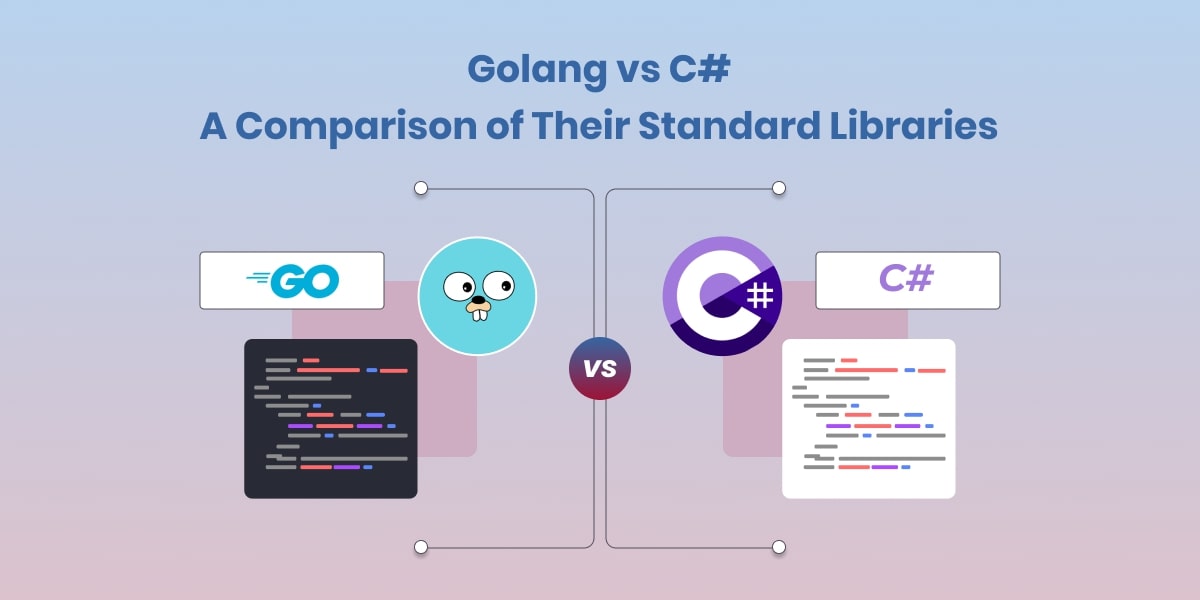Golang vs C#: A Comparison of Their Standard Libraries

Let’s embark on an enlightening journey as we compare the standard libraries of two prominent programming languages: Golang and C#. Both languages have their advantages and setbacks, but their standard libraries are crucial in defining their functionality, ease of use, and adaptability. Let’s dive in and explore what makes these languages tick!
In the world of software development, the standard library is the magician’s wand. With it, programmers can perform incredible feats and beyond with just a few keystrokes.
Why Compare Golang and C# Standard Libraries?
There’s a valid reason for every comparison in the software development cosmos. For Golang and C#, the standard libraries play an integral role in influencing a developer’s choice of the programming language.
By comparing these libraries, we’re not only looking at the difference in number, type or variety of functionalities but also in their performance, ease of implementation, and how they respectively contribute towards making each language a beneficial tool in a developer’s arsenal. Let’s first get to know what standard libraries are.
Golang: Developed by Google, Golang, also known as Go, is an open-source static type language characterized by its simplicity, efficiency, and ease of coding.
C#: Created by Microsoft as part of the .NET initiative, C# is an object-oriented language that provides a wide range of features coupled with strong typing and high-performance applications.
Golang vs C#: Which Library Reigns Supreme?
We’ll look at their performance, ease of use, and how well they can handle different tasks related to PDF and office work. Remember, there’s no ‘one-size-fits-all’ answer here. The best choice ultimately depends on your specific needs and preferences. Let’s dive in.
Performance
Performance is a critical factor when choosing a library for managing PDFs and Office documents. Both Golang and C# libraries offer impressive performance, but with slight differences.
In most cases, Golang has the edge over C# standard libraries in terms of speed. As a language, Golang is designed for efficient execution, and that reflects in the performance of its libraries. Golang is engineered to interpret, write, or modify documents with impressive speed, thanks to its highly optimized Pure Golang composition.
On the other hand, while C# standard libraries show decent performance, they may not match the speed offered by Golang, especially when dealing with large files. It’s worth noting, however, that performance can also depend on factors like system resources and the complexity of the task.
Ease of Use
Another aspect to consider is the ease of use. How straightforward is it to get started and implement each library in your project?
Golang Standard Libraries is praised for its comprehensive API and straightforward syntax, which can make working with the library a smooth experience, even for beginners. The library offers well-structured code and concise documentation, which can be a big help in the development process.
Conversely, C# Standard libraries are somewhat more complex, owing to the language’s extensive features and dynamic nature. They might initially present a steeper learning curve compared to Golang. However, once you’re familiar with the language, you’ll find C#’s libraries are extremely powerful and flexible.
Task Handling of Documents
Let’s talk about the handling of tasks. Both Golang and C# standard libraries are capable of handling a wide array of tasks related to documents like PDF and Office work. The difference lies in how they approach these tasks.
UniDoc has been crafted keeping simplicity in mind. It streamlines the workflow through its pure Golang approach – meaning that you can perform most tasks using Golang code only. This simplicity can be particularly beneficial if your tasks revolve around creating, modifying, or interpreting PDF and Office files on the fly.
In contrast, C# libraries provide broader functionality. With an extensive range of features and utilities, they cater to a wide spectrum of PDF and Office-related tasks – be it generating reports, converting formats, or embedding objects inside documents. This broad functionality requires a deeper understanding of the language, but can offer greater flexibility – especially for complex projects.
Exploring the Power of Golang’s Standard Library
If you’ve ever programmed with Golang, commonly known as Go, you’ve witnessed firsthand the power of its standard library. Go’s creators, Google engineers Robert Griesemer, Rob Pike, and Ken Thompson, designed it to be easy to use, robust, and efficient.
UniPDF and UniOffice are Unidoc libraries for Go that excel in PDF and office document handling. Key features of these libraries include:
PDF generation and manipulation: UniPDF, an integral part of the UniDoc Golang library, excels in PDF processing. It enables you to efficiently create, edit, and extract text from PDF documents. This functionality makes it ideal for generating reports and documents. With the ability to merge and split, add watermarks, and remove text, UniPDF offers a comprehensive solution for all your PDF processing needs.
Office document support: This library supports manipulating and creating of Word documents, Excel spreadsheets, and even creating PowerPoint presentations. Yes, you read that right, you can automate the entire process of creating a PPT, all thanks to UniDoc Golang library!
Over the past years, UniDoc has continually demonstrated its commitment to improving and updating the library based on users' needs and feedback. Whether it’s adding new features or improving the existing ones, their efforts are clearly visible and truly enhance the user experience.
Comparing the Performance of Golang and C# Standard Libraries
Golang, with its pared-down approach and emphasis on simplicity, tends to perform better in tasks that demand high computational speed. The fact that it is compiled directly into machine code gives it a significant speed advantage. In contrast, C# is more geared towards delivering robust and complex applications - speed is important, but not always the number one priority.
Consider the following examples:
| Task | Golang | C# |
|---|---|---|
| Data Parsing | Fastest | Slightly slower |
| Concurrency handling | Highly efficient | Less efficient |
| Graphics rendering | Decent | Outstanding |
Let’s now address the size of these libraries. Golang’s standard library is relatively small and slim, making it fast to load and less memory-intensive. On the other hand, C#’s standard library is comprehensive and extensive, which can make your applications much larger in size.
Note that these are general observations, and the performance may vary based on your specific use case, programming practices, and optimization techniques.
What about maintainability and developer productivity? Here, C# might have an advantage. Thanks to its extensive library, developers may need to write less code, which can lead to increased productivity and easier maintenance.
In the end, your choice should depend on what your project needs. If you’re after raw speed and efficiency, Golang’s standard library might be your go-to. For tasks requiring a rich set of features and intricate application development, lean on C#.
Conclusion
All things considered, there’s no denying that both Golang and C# have powerful standard libraries, each with its own dynamic functionalities and unique attributes. However, it’s the use-case, project requirements, and your level of comfort and familiarity with a language that heavily influences which one between Golang and C# standard libraries, you should opt to use.
Knowing these strengths and distinctions helps you craft the best approach for your projects. But remember, no one language or library holds default superiority over another. It’s about using the right tool for the right job.
Find out what fits your project the best and be flexible about it. Embrace diversity and never fear experimentation. You might surprise yourself!
In the end, it’s your skill and command over a language, your understanding of its library’s functionality, and how you leverage these tools that really carve the difference. So, delve in, explore, practice, and choose what sits right for you.

